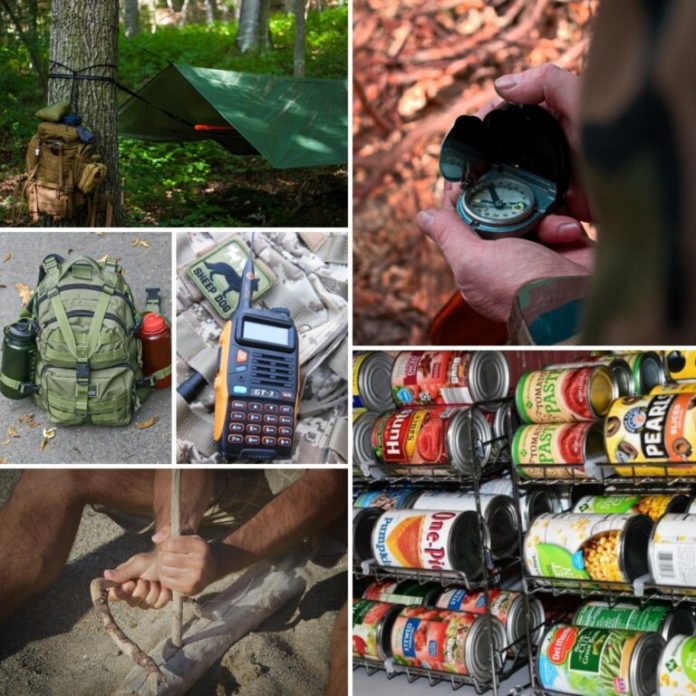Have you ever had a revelation before? Like a real revelation. Like slam on the brakes, gasp in terror, holy smokes sort of revelation? I have.
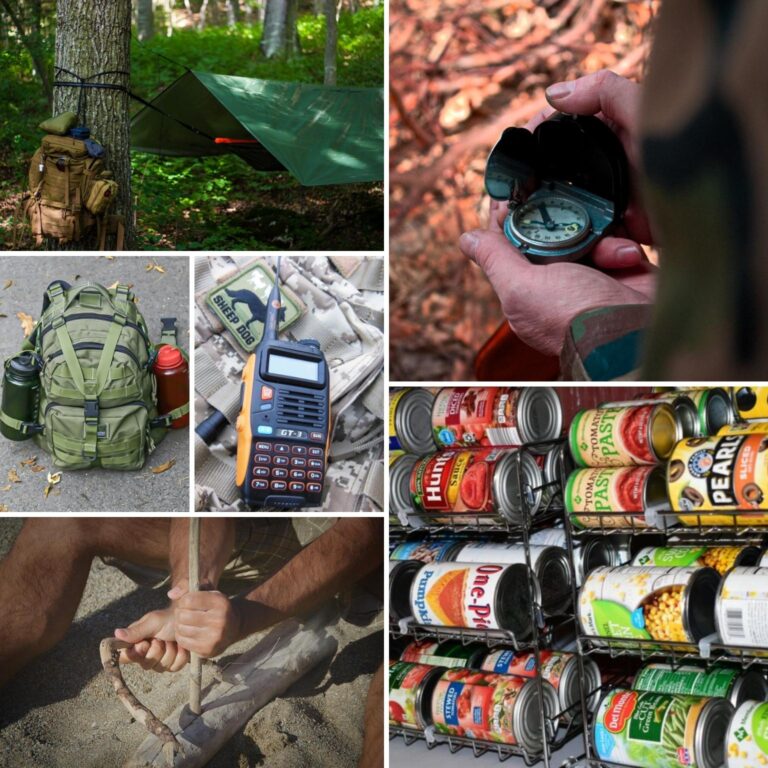
And what’s more, lately I am talking to more and more folks who have woken up in much the same way to the notion that no one is coming to save them when the chips are down.
They have understood, with cold clarity, that the only person they can truly depend on to save their own lives and the lives of their loved ones is themselves.
Call it crumbling confidence in government and police, a shivery premonition of societal strife to come or a too-late assessment of life as it is in 21st century America.
Whatever the reason, not everybody had the good fortune to be raised with prepping as a lifestyle, or the good sense to put a little bit away for a rainy day.
Now, with dawning terror, they begin to understand just how far behind they really are in the face of what is looming.
Whew! Scary stuff, huh? Maybe this describes you or maybe it doesn’t, but whatever the case that sort of sentiment is increasingly common among folks who are waking up to the notion of prepping.
However, it is not productive in any way to fret and worry over how much time you might have wasted or how little you might have left before a live event.
It is never too late to get started, and since everyone has to start somewhere the time is now. In this article we will be providing you with a six-step plan to start effectively prepping right now.
Actions Follow Words Follow Thoughts
Or said another way it is hard to take meaningful, correct action when your thought process is an absolute mess. And I am including your emotional equilibrium in there, too.
If you are one of the people I described in the opening paragraphs, you might be fretting something fierce right now.
Maybe you’ve already had a close call and are what we like to call a “death’s door” convert to prepping. Maybe you finally just saw the writing on the wall.
Whatever the case, you likely feel like you are too far behind to now make any meaningful impact on your overall state of readiness and preparedness no matter how hard you work. You feel trapped, and the walls are closing in.
Okay, bottom line it is time to snap out of it! Unless you are sitting on your sofa looking out the window and see the Grim Reaper walking up the driveway it ain’t over yet and you shouldn’t act that way.
There is always something you can do as long as you are alive, and since you are reading my helpful and informative article on the internet I’m going to assume you are very much alive.
You still get a vote and how things are going to turn out for you, so let’s make it count.
Ready to get down to business? Good. The very, very first step you must take is it getting your thoughts and emotions under control.
Tell me this:
- Do you have food to eat for the foreseeable future?
- Do you have a little bit of money in your wallet or in your bank account?
- Are you going to sleep in your climate-controlled residence in your own bed on your own pillow tonight?
If you answered yes to all of those, you got things going pretty good, and they’re still going to go pretty good for you, I’ll bet. Take a breath, relax, grab a drink and let me help you figure out your first steps.
Every situation, no matter how dire, is made more manageable by staying calm and in control of both your thoughts and your emotions. The time you spend thinking clearly is never, ever wasted. Start developing this presence of mind right now.
Step 1: Learn What Prepping Entails
Okay, now that we have calmed ourselves and understand that we have a problem we must prepare for the next order of business is precisely identifying what the danger is, where it will come from, how it will affect us, and various other characteristics about it.
Think of it in terms of understanding your enemy, of understanding the threat. If you don’t understand the threat how can you plan and prepare to counter it, much less neutralize it? Now is the time to get accurate, really drill down to brass tacks.
It is lines of inquiry like this that often lead to that terrible “snowballing” feeling of overwhelming helplessness.
The cure for that is breaking down the factors into discrete components that are easy to handle on their own.
Disaster Readiness
Pretty much every place on Earth can suffer from a variety of common natural disasters, be they weather events or something else.
Northern regions will always have to endure severe winter weather. Heat waves and rough thunderstorms plague the American South and equatorial regions.
Certain places are extremely vulnerable to powerful tornadoes, while tectonically active parts of the country always have to be ready to deal with the shaking, rattling, and rolling of an earthquake.
Understanding what natural threats are common and getting ready to face them is an important and basic part of prepping.
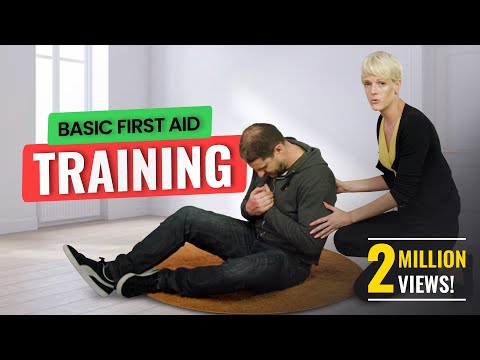
Accident Response
Prepping isn’t just about dealing with natural phenomena, no matter how destructive they might be. Everyday life furnishes plenty of ways for you or your loved ones to get hurt, sometimes critically.
Slips, trips, falls, kitchen accidents, power tool mishaps, automobile crashes, electrical shocks and more are all constant and potentially deadly hazards in modern life no matter where you are.
When lives might possibly be on the line seconds count, and you need to know how to correctly respond, especially when help is unavailable or far away.
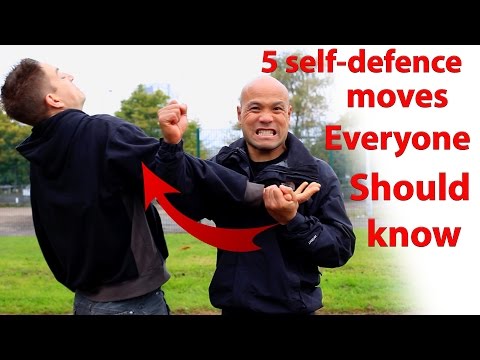
Self-Defense
As sad as it is to consider, there might be an occasion where you’ll have to defend yourself or your loved ones from predation by other people.
Who they are and why they are attacking you might vary, but the end result of resisting or obeying them might mean severe injury or death.
There are times you will have to fight for your life against your fellow man, and you had better be up to the task with fists and feet, weapons, or both. Self-defense is a basic tenet of prepping for many.

Personal and Info-Security
Our modern era has provided us with incredible conveniences thanks to information technology, but with this convenience and capability comes an entirely new set of vulnerabilities.
Criminals, even common thugs, show an increasing amount of sophistication when it comes to utilizing modern technology and social media for nefarious purposes, perpetrating scams, or just gathering actionable intelligence about potential targets.
Learning how to precisely control what information you allow out into the world and protecting your most valuable information is now part and parcel of prepping.

Stockpiling
Your grandparents knew how important it was to put things away for a rainy day, and today I will tell you how right they were!
Stockpiling food, water, medicines, useful tools, and other provisions is one of the most fundamental aspects of prepping, and that it will insulate you and your loved ones against a total breakdown of the economic gears that make modern society possible.
If you go to the grocery store and the shelves are stripped bare, how will you get food? If you already have a sizable stash at home you’ll continue to eat three meals a day.
Bugging-In
Sometimes things get so bad for whatever reason that you need to gather your family and anyone else you care about close to you before battening down the hatches at home and trying to ride the situation out.
This is known colloquially in prepping as “bugging in”, or sheltering in place for a prolonged time.
Bugging in right entails having the proper supplies, tools and plan so you can survive and sustain in place without going completely crazy.
Bugging-Out
“Bugging out”, as you’d expect, is the exact opposite of bugging in and is seen as something of a cornerstone skill in prepping.
Bugging out is an evacuation, one where you must leave behind your home and head for safer ground. Typically it is undertaken only when the situation is looking grim, as it can be risky.
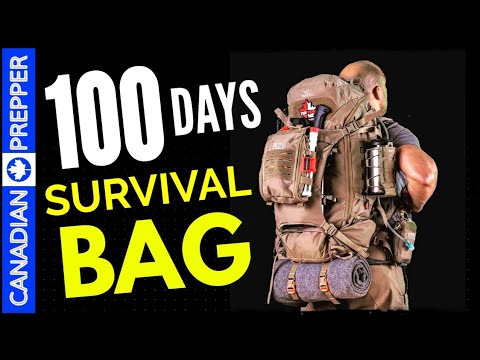
Bug-Out Bag
A bug-out bag is another prep of paramount importance, and is nothing more than a pre-packed backpack full of all the supplies and equipment you will need to sustain yourself during a bug-out movement.
Typically every member of your group, or at least every adult, will carry their own bug-out bag.
Establishing BOL’s
When the time comes to bug out you’ll need a place to bug out! And this place will hopefully be safer than the one you are fleeing.
This could be a relative’s or a friend’s house some distance away, another property you own or a patch of land, or even a secluded spot in the wilderness that can support life for a sustained period of time.

BOV
Bug-outs are not always conducted on foot, although this is the typical and romantic notion of the procedure.
If you are able, doing so by vehicle using a BOV or bug-out vehicle for the purpose is an ideal solution for making better time and carrying even more important cargo.
BOV’s can take the form of a specialty off-road vehicle or just your daily driver if it is outfitted with a few smart upgrades.
Evac Route Selection
Once you know that it is time to leave and where you are going you’ll need to know how to get there, rain or shine.
Establishing routes that you will use for evacuation, be it on foot or by vehicle, is critical to speed up your evacuation and reduce uncertainty.
Constant scouting and assessment of these routes are important as they may change with the weather, human development, or other factors.
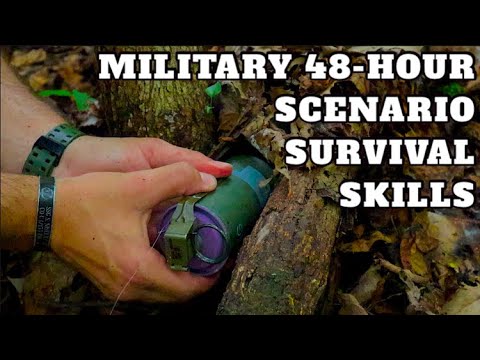
Skill Development
Becoming completely self-sufficient is a radical lifestyle change, one that will entail learning many diverse skills so you can take care of what problems you are confronted with in a survival situation.
You’ll rarely meet anyone known as a master prepper because a good prepper will forever remain a student, always learning and improving.
If you are new to prepping, you’ll have several basic but essential skills that you’ll need to begin learning, including first aid, disaster response procedure, and shelter theory.
Now, after reading that list you might feel like you have an awful lot on your plate, but if you will stick with me you’ll find that it does not take very much effort to drastically improve your state of readiness to a level that will see you and your family prepared for the most common accidents and disasters.
We won’t be breaking down every single item on the list above, as some of them swerve into more “advanced” prepping territory, but we will be giving you an excellent foundational intro from which you can rapidly build up.
Let’s keep going!
Step 2: Determine What You Are Trying to Protect
You’re doing great. Now, our next order of business is identifying what you are trying to protect and how we will protect it. What does this mean?
It means you need to know precisely what you are responsible for and what vulnerabilities you have that will need to be covered by your preparations.
We are talking about people, animals, and possessions. Note that your considerations will be almost totally unique to you.
You might have only yourself to worry about or you might have a large family nearby who can help out. Maybe your family arrangement will hinder typical survival procedures.
What if you have livestock or pets depending on you? Do you own your home, and will you take pains to try and protect or reinforce it? All of these considerations matter.
Consider this list below:
Age
How old you are will likely play a part in what responses and options are open to you when the time comes to respond to a disaster or other crisis.
Younger people are generally healthier, stronger, and have better reflexes than folks who are getting into their golden years.
Making a bug-out movement on foot could be cursory for a young person in decent shape, but virtually impossible for someone in their late 70’s!
Mentally you might only be as old as you feel, but no force of will can overcome a failing body. You should plan accordingly!
Fitness
Overall fitness level is crucial for proper planning your responses, and good fitness is a tenet of prepping.
People who are in better shape are generally harder to kill by any means, including ill health, and are far more capable physically.
If you need to work around the clock to prepare your home or just get your family out of Dodge you had better be in good shape, or otherwise, you might wind up so exhausted you cannot do anything else, or you might not be able to get it done at all.
Health
Your overall health and wellness must be considered in strictly practical terms.
Any old injuries, life-changing diseases or maladies that reduce your capability or that require specialized, continuous care must be accounted for as part of your plans.
Consider how differently a bug out might look for someone confined to a wheelchair, or what complications could arise during a disaster if you or a family member requires dialysis to survive?
If you have a permanent or semi-permanent health condition it does not mean you are doomed, it just means you have to plan around it!
Location
Where you live determines what sort of weather and overall climate you’ll be dealing with, what sort of disasters are typical, and how many other people are around you, and is one of the largest “macro” considerations when it comes to disaster preparedness.
The core requirements for survival are the same for everybody, but aside from that planning and preparing for a crisis looks very different if you live in the middle of a metropolis versus in a tiny town in the middle of Appalachia.
Family/Kids
For the majority of preppers, the single biggest consideration around which all of their plans will revolve is whether or not they have family members they are immediately responsible for, children and spouses in particular.
This is usually a major complication for planning because now you have to account for each of their individual characteristics and vulnerabilities along with your own.
Small children in particular are incredibly precious, consume tons of resources, and require constant watching and protection during any sort of emergency.
Maybe you have elderly parents that you are responsible for, and their infirmity prevents you and your fit spouse from simply making tracks.
Animals
I do not contest that animals, however important they are to us, are not as important as human lives.
But that being said many of us do own and care for animals that remain extremely important to us, and we are responsible for them.
It might be a cherished family pet or a herd/flock of livestock that are completely dependent upon us.
Those with hard hearts or a bent towards ruthless practicality might tell you to abandon them to their fates, but I don’t know many people that could, at least without trying.
Depending upon the species and the quantity of animals may greatly complicate your survival plans or just present a “curveball” that you’ll need to deal with.
A single dog or cat is not a big deal, and you can still likely bug out with them one way or another.
A herd of cows, a stable full of horses, or a flock of chickens will require special planning and skills to manage during a bug out if it is possible at all!
Better to plan on bugging in if the situation is in any way survivable.
Property
What kind of property you own and what type it is will factor into your plans.
If you live in an apartment, you might not care so much if the property is damaged by a disaster so long as it can still afford you shelter. It might even confer advantages if you don’t live on the ground floor.
Conversely, someone who owns their home might be inclined to take greater risks and put in more effort in order to attempt to protect it from a natural or man-made disaster.
People who own homes are also far more likely to bug in “at all costs” so they don’t have to leave it and all their possessions behind.
This should be considered carefully in the context of a given disaster. We’ll talk a little bit more about that in the next section.
Assessing this stuff is not hard, although it is certainly understandable that it can feel hard, even overwhelming, because you’ve never considered it before and you now have 1,000 different concerns arrowing into your brain.
Don’t give in to that feeling of overwhelm! The stuff is all easy to figure out by the numbers. At any rate, now that we have identified our specific vulnerabilities it is time for the next step.
Step 3: What Disasters and Threats Are You Facing?
Knowing what you need to protect when trouble strikes is only one part of the equation. The other is knowing what you are up against.
There are all sorts of threats that can befall us in everyday life at pretty much any time. Now, you don’t want to meditate on them too hard and that is a great way to make yourself paranoid, but you won’t have to be paranoid so long as you get prepared.
You’ll prepare for many disasters, accidents, and other emergencies using a core block of supplies and skills, but each of them brings a little something special to the table that will require the implementation of particular precautions if you want to prevent a bad outcome.
Read over the list below. What you’ll find listed are some of the most common disasters, accidents, and other crises that can befall everyday people.
Natural Disasters
Floods
Anywhere that it can rain, it can flood, though some places are far more prone to severe flooding than others.
Floods are one of the single most common disasters the world over and are responsible for billions and billions of dollars in damage and thousands of lives lost annually.
A flood is a “total package” disaster that will greatly hamper your efforts to escape, shelter in place, or await rescue and also causes a host of secondary effects that will make life difficult.
Preparing for a flood is mostly a matter of precisely understanding your home’s vulnerability to flooding and making it a point to either shelter in place or get away from the affected area before things get too bad.
Thunderstorms
A gentle, passing thunderstorm often brings with it an enjoyable ambiance, but thunderstorms are capable of growing terrifically powerful.
High winds, torrential rain, and frequent lightning make for a variety pack of hazards that you need to be prepared for.
Surviving a severe thunderstorm is mostly a matter of getting into shelter before the storm is upon you and being prepared for flooding, downed trees, and power lines.
Even at its worst, you are highly unlikely to be struck by lightning, but lightning strikes commonly set homes on fire and cause power outages; another thing to prepare for!
Tornadoes
Tornadoes often spawn from severe thunderstorms and are one of the most powerful storms on earth, and the ones with the highest sustained wind speeds.
Tornadoes vary in power but all are highly destructive, with the most potent capable of leveling or carrying away buildings, flinging cars like wiffle balls, and even hoisting train engines into the air.
Being caught outside and overtaken by a tornado is often certain death, and your best defense is to take shelter inside a hardened building or a specially designed tornado shelter.
Hurricanes
The absolute largest and most powerful storms on Earth hurricanes are a total disaster, obliterating affected areas with sustained high winds, unbelievable amounts of rainfall, pounding storm surge, and then all of the many secondary effects attendant to each.
Hurricanes also spawn tornadoes regularly to add insult to injury, and even more injury.
In the aftermath, you can expect nearly total devastation if you have suffered a direct hit from a powerful hurricane, and preventing a bad outcome depends almost entirely on evacuation for being extremely well prepared in a hardened home on the high ground. Barring that, you’ll be taking your chances.
Blizzards
Sustained cold, high winds, and gargantuan snowfall are all common effects of blizzards.
Blizzards are a yearly phenomenon in colder parts of the world, but when weather conditions are just right places that least expect it might get smacked by these powerful and debilitating winter storms.
The blizzards are often overlooked as a serious disaster compared to tornadoes, they are usually deadlier since they make travel impossible, knock out power and expose people to biting and deadly cold.
Surviving a blizzard is mostly a matter of endurance, as you must have enough supplies and enough fuel for heat to wait out the cold.
Heatwave
Heat waves are one of the least glamorous but most deadly disasters, and typically victimize the young, the very old, and the infirm.
When the body loses its ability to thermoregulate through sweating heat stroke is very close, and can be fatal.
Heatwaves also result in blackouts or brownouts due to increased demand from electrical grids (thanks to the preponderance of air conditioners being run simultaneously) and this only makes a bad situation worse.
You’ll need plenty of water and a shady place to wait out the heat if you want to survive. If you are forced to be active during a heat wave you are taking your life in your own hands!
Wildfires
Wildfires are among the very most common natural disasters, and though they rarely claim human lives they cause billions and billions of dollars in damage.
Well-intentioned but completely misguided “green” initiatives that have prevented proper management of forests and other fire-prone areas have intensified both the speed and the severity of wildfires in recent years, and they have become virtually uncontrollable.
Surviving a wildfire is so much of the time a matter of running away before it gets too close, though some intrepid and determined people have taken action with firebreaks and other methods to save their homes.
Human Threats
Robbery
It is a grim thing to consider but other people want what you have, and are entirely willing to hurt or kill you in order to get it.
Robbery is what is known as “social violence”, as there is an expectation of the desired interaction between the two parties, the robber and the victim.
Give them what they want and maybe they won’t kill you, or won’t even hurt you. Unfortunately, robbers are usually ruthless and amoral, meaning you need to know how to defend yourself in a variety of situations.
The best way to defend against a robbery is not to be chosen as a victim in the first place, and this makes situational awareness, “verbal judo” and proper positioning paramount.
If your hand is forced, you’ll have to rely on close-combat or armed self-defense techniques to beat them to the punch.
Home Invasion
By far the most terrifying and regrettably one of the most increasingly common forms of criminal violence is the home invasion.
A blitzkrieg assault on your dwelling where multiple crooks storm through your home in an effort to round up and subdue the occupants (you and family), before they can mount a meaningful defense or call for help, typically going on to ransack the home for valuables.
Defending yourself against a home invasion relies on a layered plan, consisting of hardening your home against intrusion, making it less appealing to criminals and finally being prepared to defend it with violence and repel the bad guys.
Kidnapping
A kidnap situation is harrowing for victims and victims’ relatives alike.
Typically done as a “transactional” form of violence with the expectation of ransom, kidnapping sometimes occurs when someone becomes obsessed or nurses a grudge against their victim, usually an object of infatuation.
Defending against a kidnapping relies on excellent situational awareness, escape and evasion skills, and defeating restraints.
Kidnapping is a heinous and forcible crime, and always warrants the use of lethal force in defense.
Consider that kidnapping is far more common in certain parts of the world than others, so if you travel or work in any of these places you’ll need to sharpen your game, especially if you are a “high value” mark.
Rioting
It is no stretch to say that the Western world in its entirety has entered the era of politically sanctioned violence, where one group, race, or class of people is allowed and even encouraged to turn entire communities or parts of cities upside down with nary an intervention by law enforcement.
Mobs are always extremely dangerous, and since it is an “organism” comprised of many individuals there is not simply one or two targets you can take down to save yourself.
Protecting yourself against rioting is a matter of good intelligence gathering so you know if there are any planned riots in your area, rapid avoidance as soon as they riot or conditions ripe for a riot are detected, and extricating yourself from the notice of rioters if possible.
Terrorist Attack
Since time immemorial, fanatics and motivated members of factions that would see their ideologies advanced have used terror tactics against soft targets to gain attention and force larger, better-armed opponents to submit.
Though terror attacks have mercifully been slowing down in America for a few years, we will never be truly free of them.
Terror attacks often take the form of bombings or massed gunfire from multiple assailants.
Thwarting a terrorist attack is one thing, surviving it is another, and you should be on your toes whenever you are in an area or event that would make a juicy target for terrorists.
Rapid evasion, first-aid and, if cornered, firearm skills can save you from the predations of these madmen.
Accidents
Trips and Falls
It sounds almost silly to consider in light of everything else on this list, but one of the most common and most dangerous accidents that can happen to someone is a simple slip, trip, or fall.
Whether it is wet tile in your home or a dreadful tumble from an unstable ladder the result is always the same.
Broken bones, concussions, and possible internal injuries. If you cannot summon help or help is too far away you’ll need to know how to treat these things yourself and as always an ounce of prevention is worth a pound of cure.
Car Accidents
Car accidents are a frequent and often gruesome occurrence, claiming tens of thousands of lives and causing hundreds of thousands of injuries every single year in America alone.
When multiple tons of metal and plastic collide with each other or with immovable objects at speed, the resulting impact forces can inflict grievous injuries on human bodies.
Car accidents should be avoided or damage mitigated, if possible) through the employment of active performance driving skills but should you crash (or someone crash into you) you need to know how to get yourself and loved ones out of the vehicle in a hurry and administer first-aid if needed until first responders can arrive.
House Fires
House fires are another extremely common and terribly destructive event, causing billions in damage and claiming hundreds of lives year in and year out, typically through smoke inhalation.
A small kitchen mishap and resulting fire can go from the size of a two-liter bottle to a raging and unstoppable house fire inside of 90 seconds, consuming everything you own and potentially killing everyone inside the house.
Your only chance of stopping it is through the use of a fire extinguisher in a timely fashion, but once the fire has grown too large all you can do is evacuate. Family evacuation planning is paramount for surviving a house fire.
Tool Mishaps
There are countless ways to get hurt by the things you use every single day. It’s almost enough to make you feel a little crazy.
Your hair dryer can short out. Your table saw can lop off a finger. You can get crunched by a heavy object, chopped by a lawn mower, or poisoned by common household cleaners that accidentally mixed together.
Most folks never even think of the possibility that these things could happen to them, but they happen all the time and when they happen to you they can be shockingly dangerous.
Proper maintenance, careful attention to safety procedures, and basic first-aid skills can save the day.
Firearm Mishaps
Firearms are a perpetual object of political brinkmanship and one of the most polarizing subjects in America.
Whether you are for or against them, there is no denying that they are inextricably woven into the fabric of our country and the world, and it is time to stop worrying over them and start learning about them.
As scary as you might think they are in the hands of bad guys you are far, far more likely to suffer injury from a firearm in your hands or the hands of someone you know, an accidental injury.
Powder burns and blast injuries from near contact shots and penetrating injuries from bullets are what to expect, and you’ll need to have your first-aid and basic trauma care skills dependably in hand if you want to make a difference, especially if you are at a remote shooting range.
Existential Threats
Societal Unrest
The “America That Was” is gone. Cultural division, political strife, and a divide between classes that yawns ever wider like the Grand Canyon have set us on a collision course of violence.
Tensions run high and trust is at an all-time low. The stage is set for conflict, and right now the conflict simmers at a “Cold War” level, one of unpersoning, malicious prosecution, baseless firings, and more.
The more self-sufficient you can be the better you can insulate yourself against these effects, at least in the short term.
Long-term survival will be dictated by establishing a close crèche or community of like-minded individuals you can rely on as the gap between our clashing cultures grows ever wider.
Government Overreach
If there is one thing that every government that has ever existed has in common with its fellows is that it will only ever seek to accumulate more power, more control and more influence over its subjects.
Ours is no different. We live under a tottering mountain of laws, we drown in tax and we can be jailed on the whims of people who are morally bankrupt but have nonetheless lied their way into power.
If you are “little people”, you are at the mercy of government-run amok and anything you can do to insulate or hide yourself from its notice and its activity is in your best interest.
Financial Downturn
One of the most mundane but nonetheless one of the most terrifying prospects that anyone could have to face is a severe financial downturn, resulting from joblessness or a plummeting economy.
Total disruption of finances will result in bankruptcy and homelessness in a shockingly short period of time, and this more than almost anything else on this list will likely affect you or someone you know at some point in your life.
A dependable nest egg of money and a well-stocked storeroom of all of your basic life necessities can insulate you against the worst effects of financial calamity, at least long enough to let you plan your next move.
Take some extra time to review the list above and see which disasters and man-made crises are likely to affect you in your area.
Obviously, someone living in Florida or Texas has much less to fear from blizzard conditions than hurricanes.
A proper living in remote rural Oklahoma probably isn’t worried too much about robbery or gang violence but had better well be worried sick about tornadoes when the season approaches.
All of us are more or less equally vulnerable to the accidents and mishaps listed so you’ll need to be prepared for those no matter who you are, where you live, and what your lifestyle choices are.
Step 4: Focus on Basic Requirements
When faced with all the many and varied disasters, accidents, mishaps, and general mayhem that can befall you in the previous section, it is easy to give in to a feeling of helplessness, a train of thought that suggests there is no way you can effectively protect yourself against all the harm waiting for you out there.
Don’t give in to that, and take it from me when I tell you that it not only is entirely possible, but that you can reasonably prepare for the majority using a few simple, overlapping preps.
But now is the time when it is easy to get distracted by a sort of “shiny object syndrome”.
I see it all the time with beginning preppers: It is easy to get to first base with the essentials, but easier still to head for the second base only to be distracted by thoughts about near-fictional mega-disasters and ultra-specialized gear and niche supplies.
You need to stay focused on the principal threats until you have them well and truly in hand!
To that end, you need to implement some “ground floor” planning that will help you and your loved ones get through any tough situation:
Setup Family Communications Plan
You probably are not with your family 24/7. Everyone has their own lives, schedules, and activities. Should disaster strike while you are separated how will you get in touch? How will you get in touch if your phones and internet aren’t working? That’s why you need a designated family rendezvous plan…
Establish Rendezvous Plan
To help deal with the inevitable occurrence of a comms outage when you can least afford it, you should have a plan for the typical circumstances of your day-to-day family life, one that will hopefully reunite you all in short order.
It might be as simple as having your spouse immediately retrieve the kids from school during your workday since you work so far away before you all meet at home, or perhaps you instruct your older, teenage child to make their own way back while you collect you partner and smaller child. Redundancy, certainty, and simplicity are key.

Pick at Least Two Workable BOL’s
No matter what, you should have at least two “default” bug-out locations that you can head to in times of trouble.
Everyone in the family should know where they are and how to get there if they are in any way capable of traveling themselves. Heading off into the unknown is not a valid plan when things go bad!
Walkthrough Plans for Most Likely Disasters
You should make it a point to rehearse immediate action drills for the most likely events that could occur and do so with your family, if applicable.
Family fire drills, earthquake cover drills, riot reactions while in the car and more are all valuable and will reduce stress while improving reaction time in a live event.
Gather Supplies
The following items will form the core preps that can help you get through most situations, and you can easily assemble the needed components, tools, and provisions from things you already have handy or a single trip to the department store.
Keep in mind, that the amount listed for each is the minimum you should have on hand; you’ll need much more for longer survival scenarios.
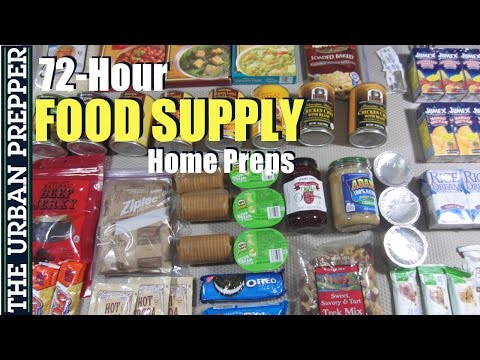
3-Day Food Supply
You should have a 3-day supply of food for every person in your family consisting primarily of calorie-dense, shelf-stable food that will not spoil quickly.
Make sure you also include the necessary can openers, disposable plates, utensils, and so forth.
Around 2,000 calories a day for an adult should be your target. Don’t forget to rotate your food supply before it expires!

3-Day Water Supply
Water is one of the most precious survival resources on Earth as you can only live for just a few days with no water at all.
You should have a supply of drinking water for everyone in your group or family totaling about a gallon a day for three days, per person!
This water will be used for drinking as well as basic hygiene when required. Individual bottles, gallon jugs, or other storage solutions are acceptable.
First-Aid Kit
You should have learned by now that there are innumerable ways to get hurt in everyday life, and exponentially more when disaster strikes.
Your basic survival first-aid kit should include a selection of supplies needed to treat minor injuries and more significant trauma.
You will need training and experience to successfully intervene when someone is seriously injured.
Extended Supply of Prescription Meds
If you or anyone in your family relies upon prescription medication for any reason make sure you keep at least an extra week’s worth on hand at all times. Much like food, medicine should be taken or disposed of before it expires.
Hygiene Supplies
You’ll need to stay clean even during a survival situation. This helps cut down on sickness and prevents infection, along with improving morale and making you more pleasant to be around.
A toiletry kit consisting of smaller versions of the things you use every day in your bathroom routine is sufficient.
Baby Wipes
Baby wipes are awesome for preppers since they allow you to clean up in a flash without using any water, at the very least extending the amount of time you can go between baths or showers.

Garbage Bags
Heavy-duty, thick garbage bags are invaluable during survival situations because they will allow you to dispose of and store trash or human waste when typical utilities and weekly services are shut down.
They are also useful for employing as ground covers, improvised ponchos, and sealing holes in windows or roofs.
Spare Clothing
You can count on your clothing getting dirty in a hurry during a survival situation, and it could potentially be contaminated with blood or other hazardous materials.
You would be wise to have a stash of clothing for all family members as a dedicated part of your survival gear.
Make sure the clothing is suitable for the season; durable, and comfortable and you don’t forget socks, underwear, gloves, and headgear.

Flashlights, Headlamps, and Lanterns
Any disaster worth the name is likely to knock out power for an extended time in your region.
Darkness will conceal many dangers, and make meaningful efforts to perform work or affect self-rescue extremely difficult or even impossible.
Flashlights, headlamps, and lanterns will allow you to banish the darkness with the flick of a switch. Get plenty, and make sure they work.
Emergency Radio
One vital prep for everybody is an emergency radio, a small, typically hand-cranked or battery-powered radio designed to receive emergency notification broadcasts and updates via designated government channels.
Modern versions of these radios often include a flashlight, onboard battery bank, and USB slots for recharging your mobile devices.
Batteries
All of your electronics may continue to work in the aftermath of a disaster or crisis, but they will only work as long as they have electricity!
You need backup power supplies in the form of disposable batteries for flashlights and other tools, and rechargeable power banks to fuel your cell phones.

Chlorine Bleach
Bleach is a survival superstar, not just a laundry day staple.
Chlorine bleach is excellent for disinfecting surfaces that are contaminated with biohazardous material or even adding to water that has likely been contaminated by the same, readily purifying it and making it safe to drink.
You’ll need to very precisely administer bleach according to a specific ratio for this, and so long as you are cautious it is safe.
Make sure you use only unscented, non-thickened, regular chlorine bleach for this purpose.
Dust Masks or Respirators
Disasters, severe accidents, and major terrorist attacks will often result in fires or damage that will heave tremendous amounts of dust and smoke into the air.
Breathing in contaminated air can potentially asphyxiate you or at the very least cause long-term health problems.
N95 rated or better dust masks or respirators with appropriate filter cartridges will keep your lungs safe and keep you breathing.
Fire Extinguishers
We talked about the need for fire extinguishers above, as they are one of the only things that will reliably put out a fire before it grows completely out of control.
Get two ABC-rated fire extinguishers for your home, the largest ones you can easily handle, and keep them serviced.
Make sure you store them where a fire is not likely to start so you are sure you’ll have access to them!

Home Tool Kit
You’ll have plenty of calls for fixing things in the aftermath of a disaster. A home toolkit consisting of common hand tools such as hammers, saws, pliers, screwdrivers along with various fasteners and some spare lumber will allow you to make hasty repairs or improvise what you need.
Power tools are great and all, but you won’t be sure of having the electricity needed to power them.
Some gasoline-powered tools like chainsaws do make sense in rural and suburban environments, however.
Sleeping Bags
Assuming your home is still inhabitable in the aftermath of a disaster it is likely to become very chilly if the power or gas is knocked out.
You will stay warmer with far less effort by snuggling into a sleeping bag versus trying to cover up in a large and drafty room.
Lighters and Matches
The ability to start a fire on demand is essential, as it can provide warmth, light, heat for cooking or boiling water, and even allow you to signal for rescue.
It is a great idea to learn primitive fire-starting methods, but there is no reason you shouldn’t have plenty of lighters and matches on hand until you master that particular skill.
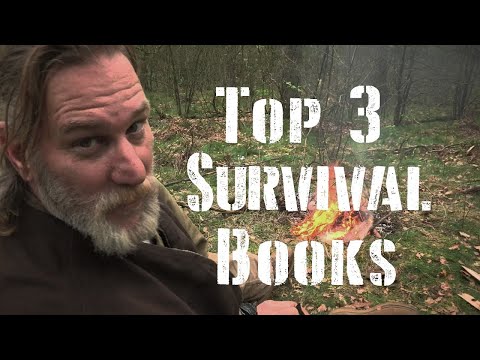
Survival Manual
You are a brand new prepper and have much to learn. Until you know it all by heart, it is a good idea to have a general-purpose survival manual that you can refer to in a pinch.
Even for seasoned preppers, these make excellent reference materials and belong in every survival kit.
Stash of Cash
I mentioned above that the power will usually go out over a wide area when a major disaster or some other event has occurred.
This means you absolutely cannot rely on credit, debit, or any other kind of card for the duration.
Cash always speaks, and you should have a small wad of it set aside strictly for use in an emergency. Don’t raid this piggy bank no matter what, and if you are forced to replace it at once!
You might read through the list of items above and be left scratching your head. Surely you need more esoteric and specialized gear than this, right?
You might, one day, but believe it or not, these simple items and preps are all that are needed to survive the overwhelming majority of things that are likely to happen to you in the course of your life.
In the next and final section, we will be providing you with a road map for acquiring the skills you will need to grow as a prepper now that you have the beginning core of gear and provisions. Keep going, the finish line is in sight!
Step 5: Improve Skillsets
So far, so good. You successfully identified the most pressing threats, likewise identified your specific vulnerabilities, and then took diligent, sustained action to correct or otherwise cover those vulnerabilities.
Give yourself a hearty round of applause, because this is the basic “life cycle” of preparation: Identifying a vulnerability and correcting it.
Now, the time has probably come for you to start diversifying your efforts into adjacent skillsets that will turn you into a more capable person in any typical survival situation.
Remember: It is almost always better to be a generalist or well-rounded prepper than a super-specialized one, so make sure you spread your efforts around.
Check out the following list, pick one that appeals to you, and get to it!

Medical Skills
If you learn only one skill set applicable to survival make it medical skills. You’ll often hear around the prepper-sphere that a good prepper must be their own first responder.
It’s true. When the chips are down and the sky is falling you won’t be able to call paramedics, go see your doctor or wait for the fire department to arrive.
If you or someone you love is injured you must be able to take care of the issue and at least stabilize them.
You’ll have far more cause and opportunity to use these skills than any other throughout your life.

Shelter Skills
After the cavalcade of horrors, we described in the section on disasters and accidents above you might be surprised to learn that the single, biggest killer in any given survival situation is a simple exposure to the elements.
The weather is merciless, and especially when the temperature drops your life can be endangered in very short order. Without appropriate shelter or clothing, cold weather can kill you in just a few hours.
Learning how to stay warm with the appropriate supplies or with whatever materials you can scavenge along with learning how to build and maintain a fire will go a long way to keeping you alive in any conditions.

Navigation Skills
It is difficult to overstate just how radically the landscape can be reshaped by major disasters.
Even if it isn’t, you will probably find yourself needing to detour around clogged highways, stampeding crowds of people, and other hazards.
It is imperative that you know how to navigate using traditional methods, specifically with a map, compass, and road atlas.
GPS systems are excellent and more durable than you might think, but incredibly intricate and could be prone to failure depending on the circumstances.
Don’t risk it, and make sure you can always get to your destination by learning traditional land navigation skills.

Self-Defense Skills
No matter how peaceful you are chances are at one point you will eventually run into people that want to hurt you, either out of sport, malice, or because they want something you have.
You must learn how to repel or neutralize the baddies using either hand-to-hand skills or weapons, particularly firearms. Getting embroiled in a genuine life or death fight is no time for “I’ll figure it out”.
Repair and Improvisation
In life, and in survival situations, things are going to go wrong. Vital equipment will break or go missing. A solution that you thought was a sure thing will turn out to be anything but.
Curveballs will be coming fast and furious. There is nothing to do but fix it, or improvise a way around it.
Learning to think on your feet, make do with what you have or make something that can take care of business and save the day is invaluable in a survival situation.
This isn’t necessarily a skill that you can go take a class for or read a book about, but if you force yourself to approach any given problem on your own before you resort to calling the experts, you will soon find that you turn into a regular MacGyver.
Conclusion
Getting a late start on prepping and realizing that you have precious little time to prepare for a pressing threat is one of the most stomach-churning, nerve-racking realizations that anybody can experience.
But you need not give in to fear and accept your fate, whatever you think it is. It is entirely possible to start at zero and implement meaningful action that will improve your chances of obtaining a positive outcome today.
You’ll need to act rationally and work hard, but so long as you are alive there is always something you can do, and with some diligent effort you’ll find that you are more than capable of handling whatever comes your way.



